Analysis of Conflict Causes in the Workplace: Tesco Case Study
VerifiedAdded on 2020/01/07
|13
|3942
|650
Report
AI Summary
This report presents a comprehensive analysis of the causes of workplace conflict, using Tesco as a case study. It delves into the critical role of leadership in conflict management, emphasizing the impact of employee diversity, communication barriers, and misunderstandings on workplace dynamics. The research aims to explore how these factors contribute to conflict and offers insights into effective management strategies. The study employs a descriptive research design, utilizing both primary and secondary data collection methods, including questionnaires and literature reviews, to gather a thorough understanding of the subject matter. The report examines the effects of organizational conflict on a firm's operations, highlighting the importance of addressing these issues to maintain employee motivation, customer satisfaction, and overall business performance. The findings of this research offer valuable guidance for leaders and organizations seeking to mitigate conflict and foster a more harmonious and productive work environment.
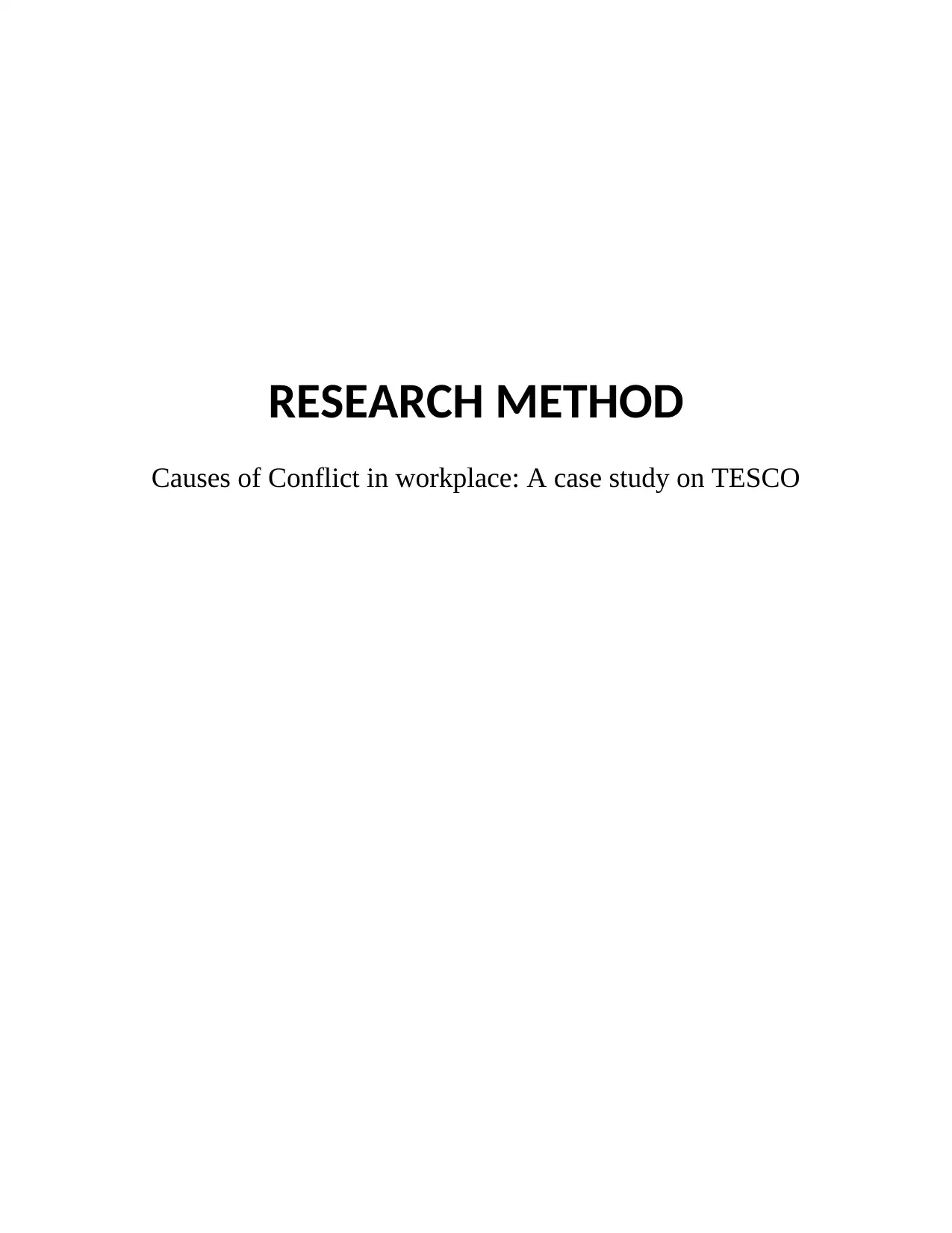
RESEARCH METHOD
Causes of Conflict in workplace: A case study on TESCO
Causes of Conflict in workplace: A case study on TESCO
Paraphrase This Document
Need a fresh take? Get an instant paraphrase of this document with our AI Paraphraser
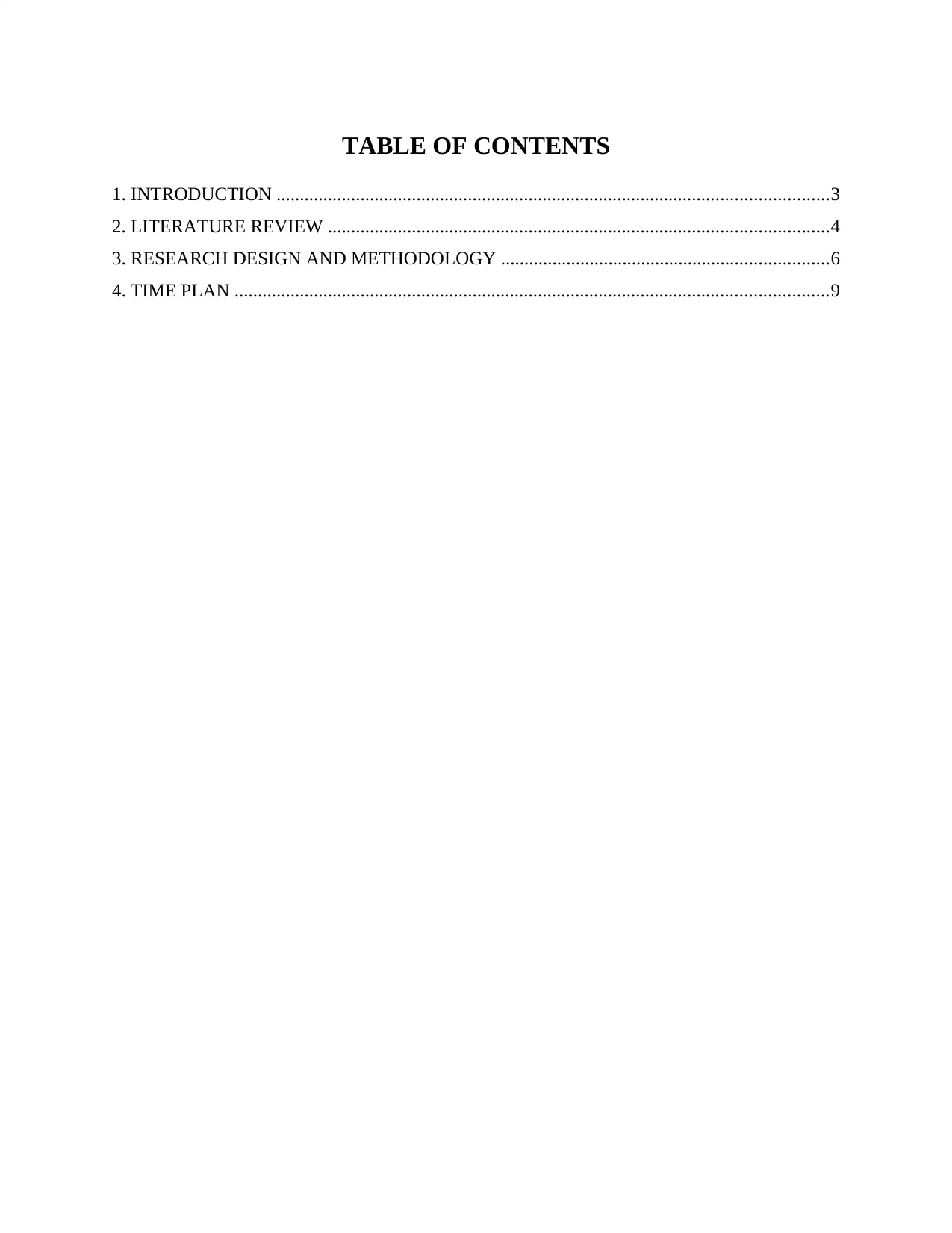
TABLE OF CONTENTS
1. INTRODUCTION ......................................................................................................................3
2. LITERATURE REVIEW ...........................................................................................................4
3. RESEARCH DESIGN AND METHODOLOGY ......................................................................6
4. TIME PLAN ...............................................................................................................................9
1. INTRODUCTION ......................................................................................................................3
2. LITERATURE REVIEW ...........................................................................................................4
3. RESEARCH DESIGN AND METHODOLOGY ......................................................................6
4. TIME PLAN ...............................................................................................................................9
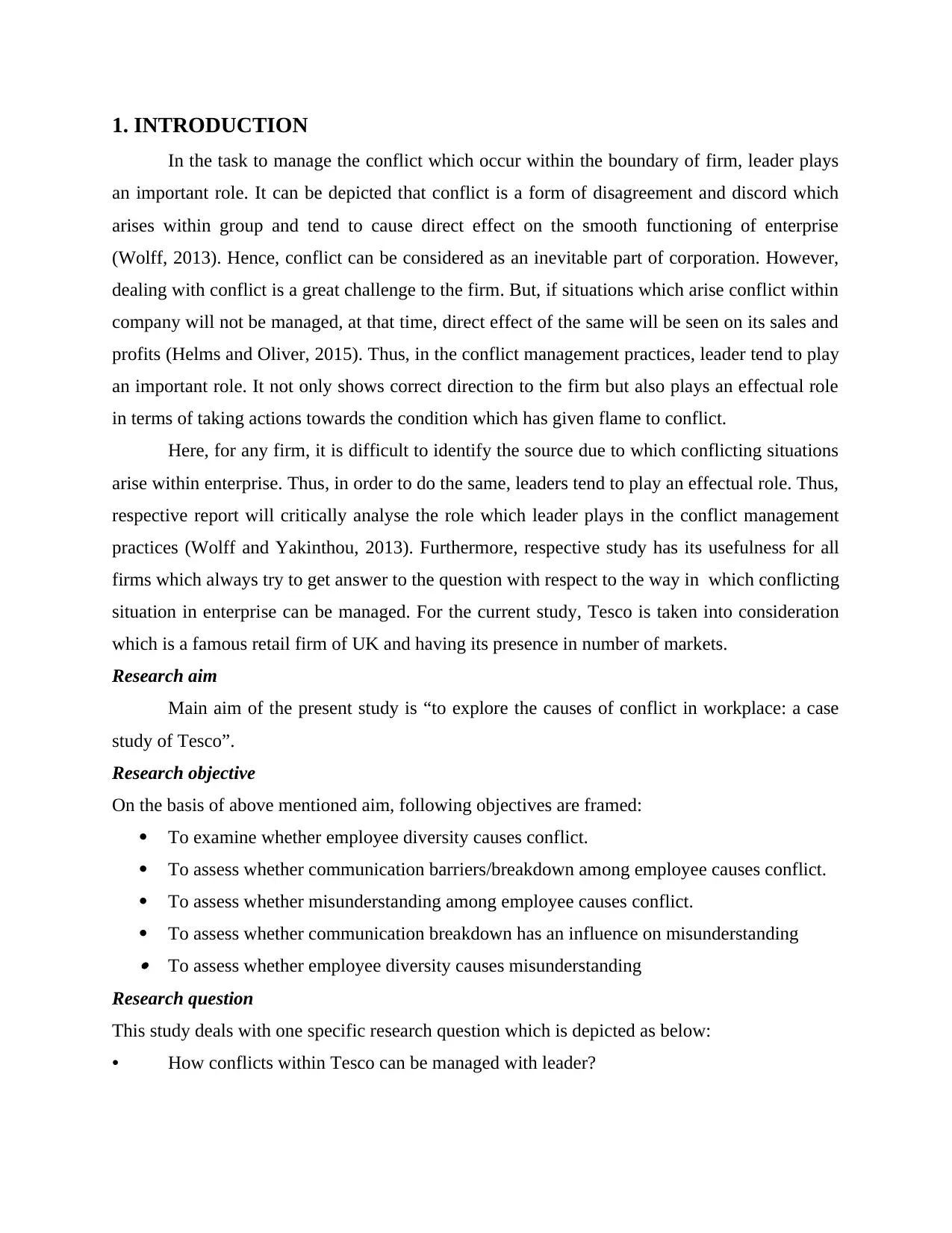
1. INTRODUCTION
In the task to manage the conflict which occur within the boundary of firm, leader plays
an important role. It can be depicted that conflict is a form of disagreement and discord which
arises within group and tend to cause direct effect on the smooth functioning of enterprise
(Wolff, 2013). Hence, conflict can be considered as an inevitable part of corporation. However,
dealing with conflict is a great challenge to the firm. But, if situations which arise conflict within
company will not be managed, at that time, direct effect of the same will be seen on its sales and
profits (Helms and Oliver, 2015). Thus, in the conflict management practices, leader tend to play
an important role. It not only shows correct direction to the firm but also plays an effectual role
in terms of taking actions towards the condition which has given flame to conflict.
Here, for any firm, it is difficult to identify the source due to which conflicting situations
arise within enterprise. Thus, in order to do the same, leaders tend to play an effectual role. Thus,
respective report will critically analyse the role which leader plays in the conflict management
practices (Wolff and Yakinthou, 2013). Furthermore, respective study has its usefulness for all
firms which always try to get answer to the question with respect to the way in which conflicting
situation in enterprise can be managed. For the current study, Tesco is taken into consideration
which is a famous retail firm of UK and having its presence in number of markets.
Research aim
Main aim of the present study is “to explore the causes of conflict in workplace: a case
study of Tesco”.
Research objective
On the basis of above mentioned aim, following objectives are framed:
To examine whether employee diversity causes conflict.
To assess whether communication barriers/breakdown among employee causes conflict.
To assess whether misunderstanding among employee causes conflict.
To assess whether communication breakdown has an influence on misunderstanding To assess whether employee diversity causes misunderstanding
Research question
This study deals with one specific research question which is depicted as below:
• How conflicts within Tesco can be managed with leader?
In the task to manage the conflict which occur within the boundary of firm, leader plays
an important role. It can be depicted that conflict is a form of disagreement and discord which
arises within group and tend to cause direct effect on the smooth functioning of enterprise
(Wolff, 2013). Hence, conflict can be considered as an inevitable part of corporation. However,
dealing with conflict is a great challenge to the firm. But, if situations which arise conflict within
company will not be managed, at that time, direct effect of the same will be seen on its sales and
profits (Helms and Oliver, 2015). Thus, in the conflict management practices, leader tend to play
an important role. It not only shows correct direction to the firm but also plays an effectual role
in terms of taking actions towards the condition which has given flame to conflict.
Here, for any firm, it is difficult to identify the source due to which conflicting situations
arise within enterprise. Thus, in order to do the same, leaders tend to play an effectual role. Thus,
respective report will critically analyse the role which leader plays in the conflict management
practices (Wolff and Yakinthou, 2013). Furthermore, respective study has its usefulness for all
firms which always try to get answer to the question with respect to the way in which conflicting
situation in enterprise can be managed. For the current study, Tesco is taken into consideration
which is a famous retail firm of UK and having its presence in number of markets.
Research aim
Main aim of the present study is “to explore the causes of conflict in workplace: a case
study of Tesco”.
Research objective
On the basis of above mentioned aim, following objectives are framed:
To examine whether employee diversity causes conflict.
To assess whether communication barriers/breakdown among employee causes conflict.
To assess whether misunderstanding among employee causes conflict.
To assess whether communication breakdown has an influence on misunderstanding To assess whether employee diversity causes misunderstanding
Research question
This study deals with one specific research question which is depicted as below:
• How conflicts within Tesco can be managed with leader?
⊘ This is a preview!⊘
Do you want full access?
Subscribe today to unlock all pages.

Trusted by 1+ million students worldwide
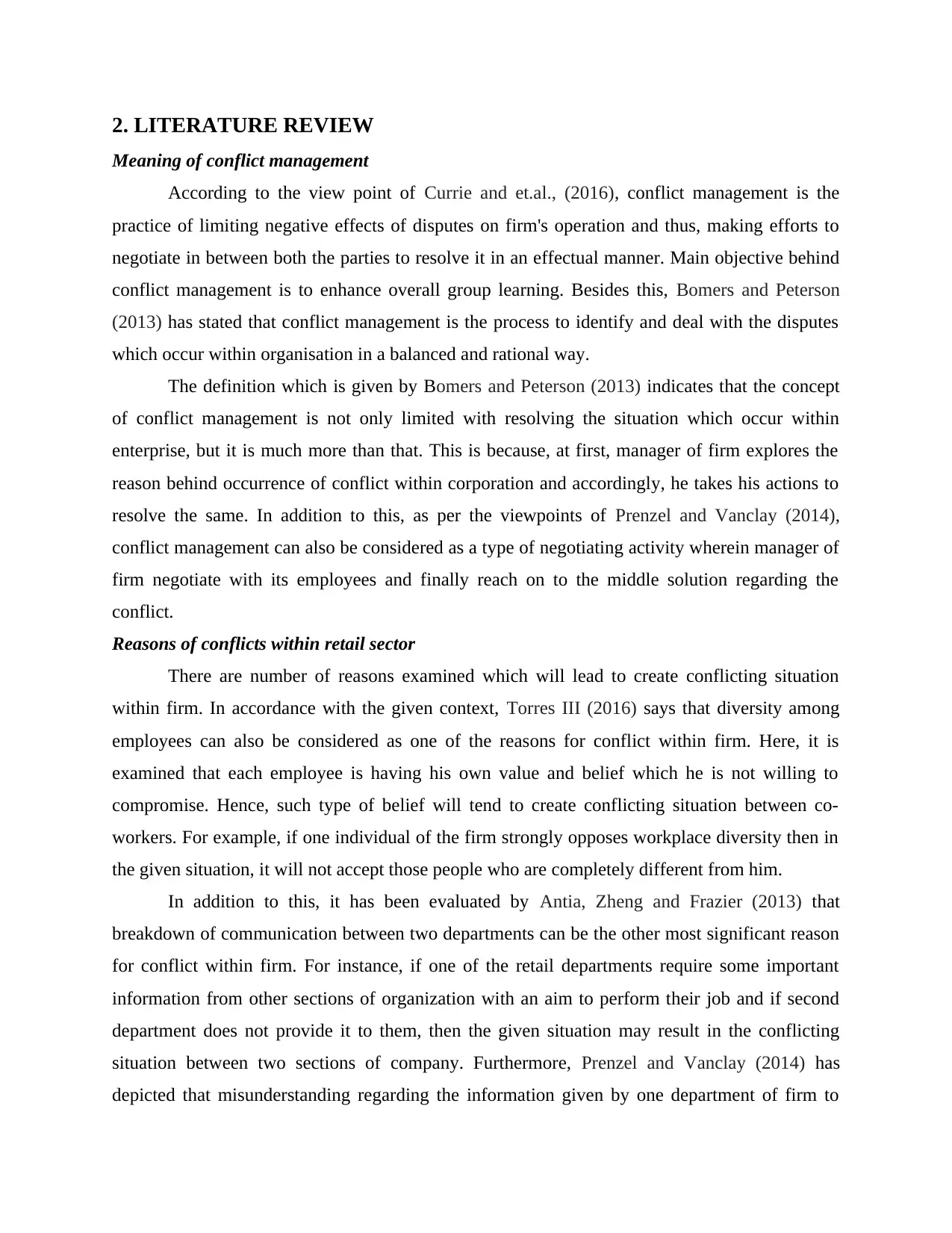
2. LITERATURE REVIEW
Meaning of conflict management
According to the view point of Currie and et.al., (2016), conflict management is the
practice of limiting negative effects of disputes on firm's operation and thus, making efforts to
negotiate in between both the parties to resolve it in an effectual manner. Main objective behind
conflict management is to enhance overall group learning. Besides this, Bomers and Peterson
(2013) has stated that conflict management is the process to identify and deal with the disputes
which occur within organisation in a balanced and rational way.
The definition which is given by Bomers and Peterson (2013) indicates that the concept
of conflict management is not only limited with resolving the situation which occur within
enterprise, but it is much more than that. This is because, at first, manager of firm explores the
reason behind occurrence of conflict within corporation and accordingly, he takes his actions to
resolve the same. In addition to this, as per the viewpoints of Prenzel and Vanclay (2014),
conflict management can also be considered as a type of negotiating activity wherein manager of
firm negotiate with its employees and finally reach on to the middle solution regarding the
conflict.
Reasons of conflicts within retail sector
There are number of reasons examined which will lead to create conflicting situation
within firm. In accordance with the given context, Torres III (2016) says that diversity among
employees can also be considered as one of the reasons for conflict within firm. Here, it is
examined that each employee is having his own value and belief which he is not willing to
compromise. Hence, such type of belief will tend to create conflicting situation between co-
workers. For example, if one individual of the firm strongly opposes workplace diversity then in
the given situation, it will not accept those people who are completely different from him.
In addition to this, it has been evaluated by Antia, Zheng and Frazier (2013) that
breakdown of communication between two departments can be the other most significant reason
for conflict within firm. For instance, if one of the retail departments require some important
information from other sections of organization with an aim to perform their job and if second
department does not provide it to them, then the given situation may result in the conflicting
situation between two sections of company. Furthermore, Prenzel and Vanclay (2014) has
depicted that misunderstanding regarding the information given by one department of firm to
Meaning of conflict management
According to the view point of Currie and et.al., (2016), conflict management is the
practice of limiting negative effects of disputes on firm's operation and thus, making efforts to
negotiate in between both the parties to resolve it in an effectual manner. Main objective behind
conflict management is to enhance overall group learning. Besides this, Bomers and Peterson
(2013) has stated that conflict management is the process to identify and deal with the disputes
which occur within organisation in a balanced and rational way.
The definition which is given by Bomers and Peterson (2013) indicates that the concept
of conflict management is not only limited with resolving the situation which occur within
enterprise, but it is much more than that. This is because, at first, manager of firm explores the
reason behind occurrence of conflict within corporation and accordingly, he takes his actions to
resolve the same. In addition to this, as per the viewpoints of Prenzel and Vanclay (2014),
conflict management can also be considered as a type of negotiating activity wherein manager of
firm negotiate with its employees and finally reach on to the middle solution regarding the
conflict.
Reasons of conflicts within retail sector
There are number of reasons examined which will lead to create conflicting situation
within firm. In accordance with the given context, Torres III (2016) says that diversity among
employees can also be considered as one of the reasons for conflict within firm. Here, it is
examined that each employee is having his own value and belief which he is not willing to
compromise. Hence, such type of belief will tend to create conflicting situation between co-
workers. For example, if one individual of the firm strongly opposes workplace diversity then in
the given situation, it will not accept those people who are completely different from him.
In addition to this, it has been evaluated by Antia, Zheng and Frazier (2013) that
breakdown of communication between two departments can be the other most significant reason
for conflict within firm. For instance, if one of the retail departments require some important
information from other sections of organization with an aim to perform their job and if second
department does not provide it to them, then the given situation may result in the conflicting
situation between two sections of company. Furthermore, Prenzel and Vanclay (2014) has
depicted that misunderstanding regarding the information given by one department of firm to
Paraphrase This Document
Need a fresh take? Get an instant paraphrase of this document with our AI Paraphraser
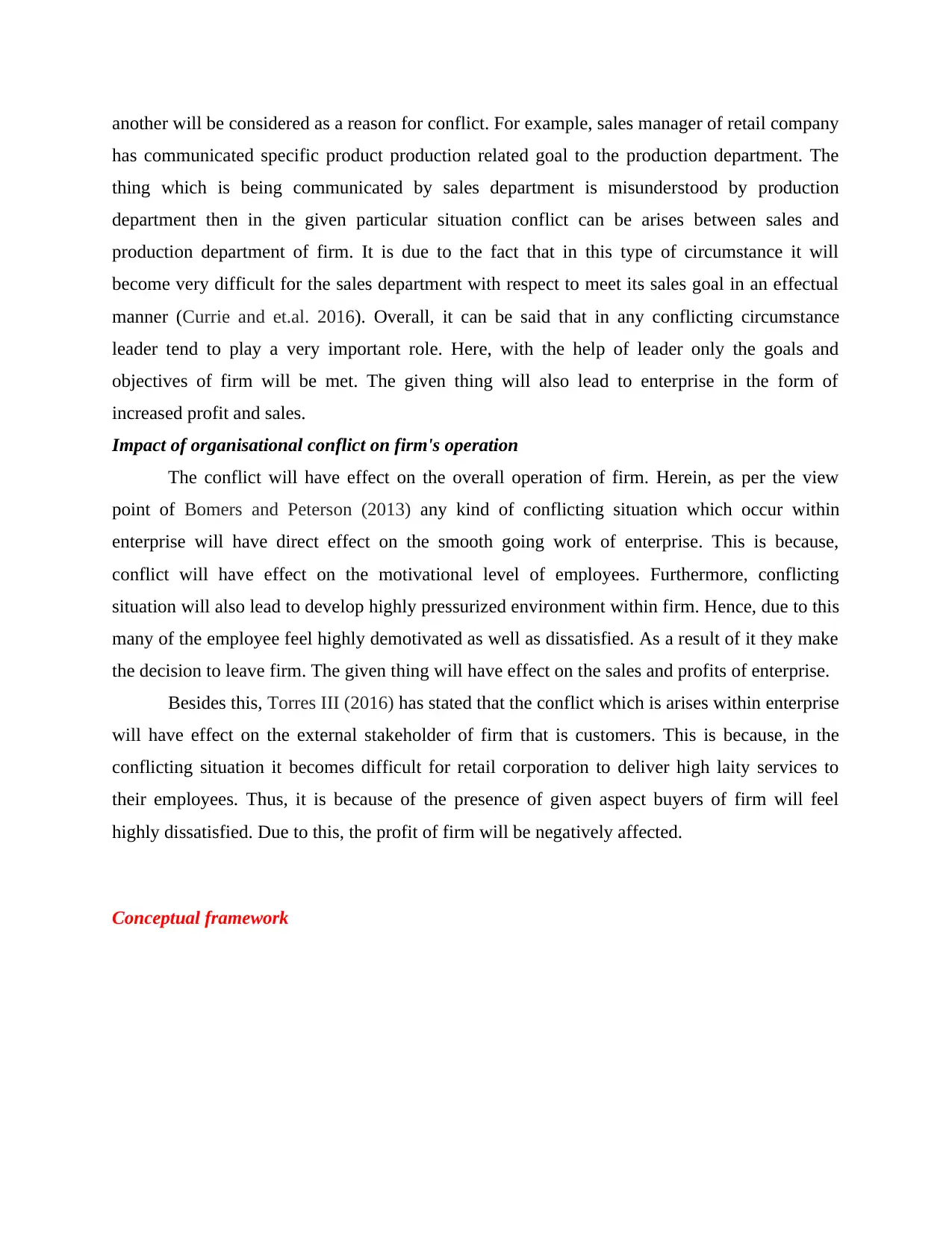
another will be considered as a reason for conflict. For example, sales manager of retail company
has communicated specific product production related goal to the production department. The
thing which is being communicated by sales department is misunderstood by production
department then in the given particular situation conflict can be arises between sales and
production department of firm. It is due to the fact that in this type of circumstance it will
become very difficult for the sales department with respect to meet its sales goal in an effectual
manner (Currie and et.al. 2016). Overall, it can be said that in any conflicting circumstance
leader tend to play a very important role. Here, with the help of leader only the goals and
objectives of firm will be met. The given thing will also lead to enterprise in the form of
increased profit and sales.
Impact of organisational conflict on firm's operation
The conflict will have effect on the overall operation of firm. Herein, as per the view
point of Bomers and Peterson (2013) any kind of conflicting situation which occur within
enterprise will have direct effect on the smooth going work of enterprise. This is because,
conflict will have effect on the motivational level of employees. Furthermore, conflicting
situation will also lead to develop highly pressurized environment within firm. Hence, due to this
many of the employee feel highly demotivated as well as dissatisfied. As a result of it they make
the decision to leave firm. The given thing will have effect on the sales and profits of enterprise.
Besides this, Torres III (2016) has stated that the conflict which is arises within enterprise
will have effect on the external stakeholder of firm that is customers. This is because, in the
conflicting situation it becomes difficult for retail corporation to deliver high laity services to
their employees. Thus, it is because of the presence of given aspect buyers of firm will feel
highly dissatisfied. Due to this, the profit of firm will be negatively affected.
Conceptual framework
has communicated specific product production related goal to the production department. The
thing which is being communicated by sales department is misunderstood by production
department then in the given particular situation conflict can be arises between sales and
production department of firm. It is due to the fact that in this type of circumstance it will
become very difficult for the sales department with respect to meet its sales goal in an effectual
manner (Currie and et.al. 2016). Overall, it can be said that in any conflicting circumstance
leader tend to play a very important role. Here, with the help of leader only the goals and
objectives of firm will be met. The given thing will also lead to enterprise in the form of
increased profit and sales.
Impact of organisational conflict on firm's operation
The conflict will have effect on the overall operation of firm. Herein, as per the view
point of Bomers and Peterson (2013) any kind of conflicting situation which occur within
enterprise will have direct effect on the smooth going work of enterprise. This is because,
conflict will have effect on the motivational level of employees. Furthermore, conflicting
situation will also lead to develop highly pressurized environment within firm. Hence, due to this
many of the employee feel highly demotivated as well as dissatisfied. As a result of it they make
the decision to leave firm. The given thing will have effect on the sales and profits of enterprise.
Besides this, Torres III (2016) has stated that the conflict which is arises within enterprise
will have effect on the external stakeholder of firm that is customers. This is because, in the
conflicting situation it becomes difficult for retail corporation to deliver high laity services to
their employees. Thus, it is because of the presence of given aspect buyers of firm will feel
highly dissatisfied. Due to this, the profit of firm will be negatively affected.
Conceptual framework
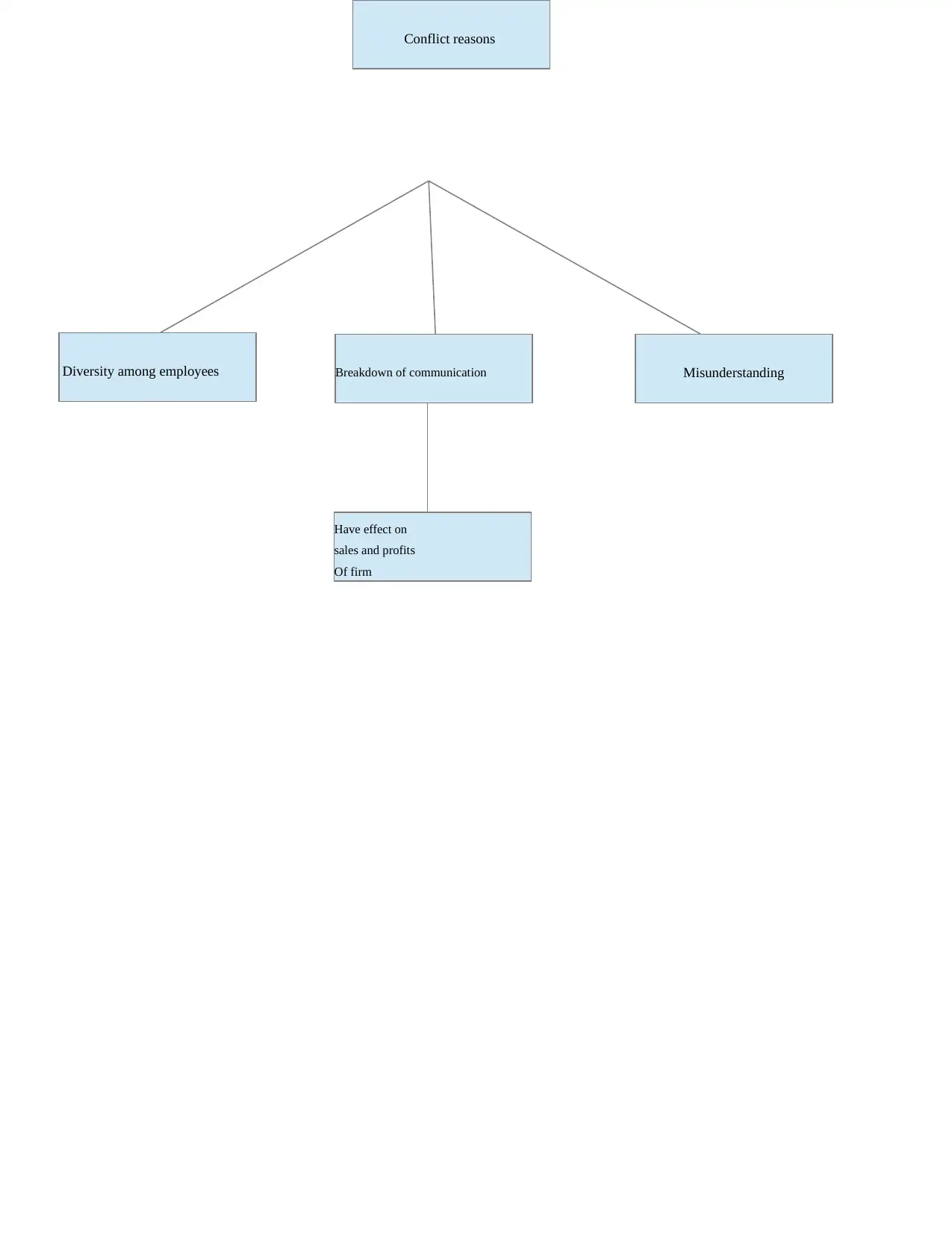
Conflict reasons
Diversity among employees Breakdown of communication Misunderstanding
Have effect on
sales and profits
Of firm
Diversity among employees Breakdown of communication Misunderstanding
Have effect on
sales and profits
Of firm
⊘ This is a preview!⊘
Do you want full access?
Subscribe today to unlock all pages.

Trusted by 1+ million students worldwide
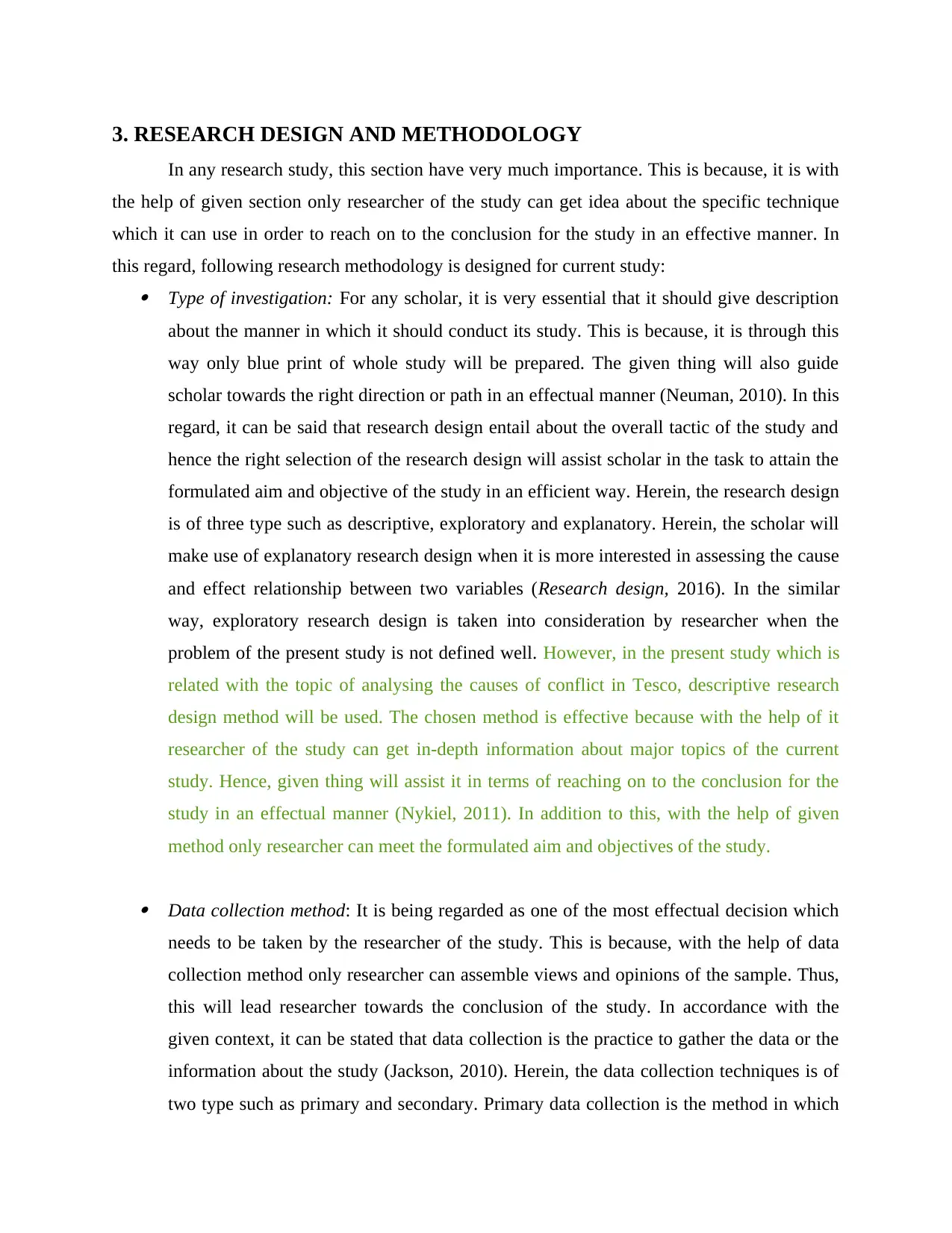
3. RESEARCH DESIGN AND METHODOLOGY
In any research study, this section have very much importance. This is because, it is with
the help of given section only researcher of the study can get idea about the specific technique
which it can use in order to reach on to the conclusion for the study in an effective manner. In
this regard, following research methodology is designed for current study: Type of investigation: For any scholar, it is very essential that it should give description
about the manner in which it should conduct its study. This is because, it is through this
way only blue print of whole study will be prepared. The given thing will also guide
scholar towards the right direction or path in an effectual manner (Neuman, 2010). In this
regard, it can be said that research design entail about the overall tactic of the study and
hence the right selection of the research design will assist scholar in the task to attain the
formulated aim and objective of the study in an efficient way. Herein, the research design
is of three type such as descriptive, exploratory and explanatory. Herein, the scholar will
make use of explanatory research design when it is more interested in assessing the cause
and effect relationship between two variables (Research design, 2016). In the similar
way, exploratory research design is taken into consideration by researcher when the
problem of the present study is not defined well. However, in the present study which is
related with the topic of analysing the causes of conflict in Tesco, descriptive research
design method will be used. The chosen method is effective because with the help of it
researcher of the study can get in-depth information about major topics of the current
study. Hence, given thing will assist it in terms of reaching on to the conclusion for the
study in an effectual manner (Nykiel, 2011). In addition to this, with the help of given
method only researcher can meet the formulated aim and objectives of the study.
Data collection method: It is being regarded as one of the most effectual decision which
needs to be taken by the researcher of the study. This is because, with the help of data
collection method only researcher can assemble views and opinions of the sample. Thus,
this will lead researcher towards the conclusion of the study. In accordance with the
given context, it can be stated that data collection is the practice to gather the data or the
information about the study (Jackson, 2010). Herein, the data collection techniques is of
two type such as primary and secondary. Primary data collection is the method in which
In any research study, this section have very much importance. This is because, it is with
the help of given section only researcher of the study can get idea about the specific technique
which it can use in order to reach on to the conclusion for the study in an effective manner. In
this regard, following research methodology is designed for current study: Type of investigation: For any scholar, it is very essential that it should give description
about the manner in which it should conduct its study. This is because, it is through this
way only blue print of whole study will be prepared. The given thing will also guide
scholar towards the right direction or path in an effectual manner (Neuman, 2010). In this
regard, it can be said that research design entail about the overall tactic of the study and
hence the right selection of the research design will assist scholar in the task to attain the
formulated aim and objective of the study in an efficient way. Herein, the research design
is of three type such as descriptive, exploratory and explanatory. Herein, the scholar will
make use of explanatory research design when it is more interested in assessing the cause
and effect relationship between two variables (Research design, 2016). In the similar
way, exploratory research design is taken into consideration by researcher when the
problem of the present study is not defined well. However, in the present study which is
related with the topic of analysing the causes of conflict in Tesco, descriptive research
design method will be used. The chosen method is effective because with the help of it
researcher of the study can get in-depth information about major topics of the current
study. Hence, given thing will assist it in terms of reaching on to the conclusion for the
study in an effectual manner (Nykiel, 2011). In addition to this, with the help of given
method only researcher can meet the formulated aim and objectives of the study.
Data collection method: It is being regarded as one of the most effectual decision which
needs to be taken by the researcher of the study. This is because, with the help of data
collection method only researcher can assemble views and opinions of the sample. Thus,
this will lead researcher towards the conclusion of the study. In accordance with the
given context, it can be stated that data collection is the practice to gather the data or the
information about the study (Jackson, 2010). Herein, the data collection techniques is of
two type such as primary and secondary. Primary data collection is the method in which
Paraphrase This Document
Need a fresh take? Get an instant paraphrase of this document with our AI Paraphraser
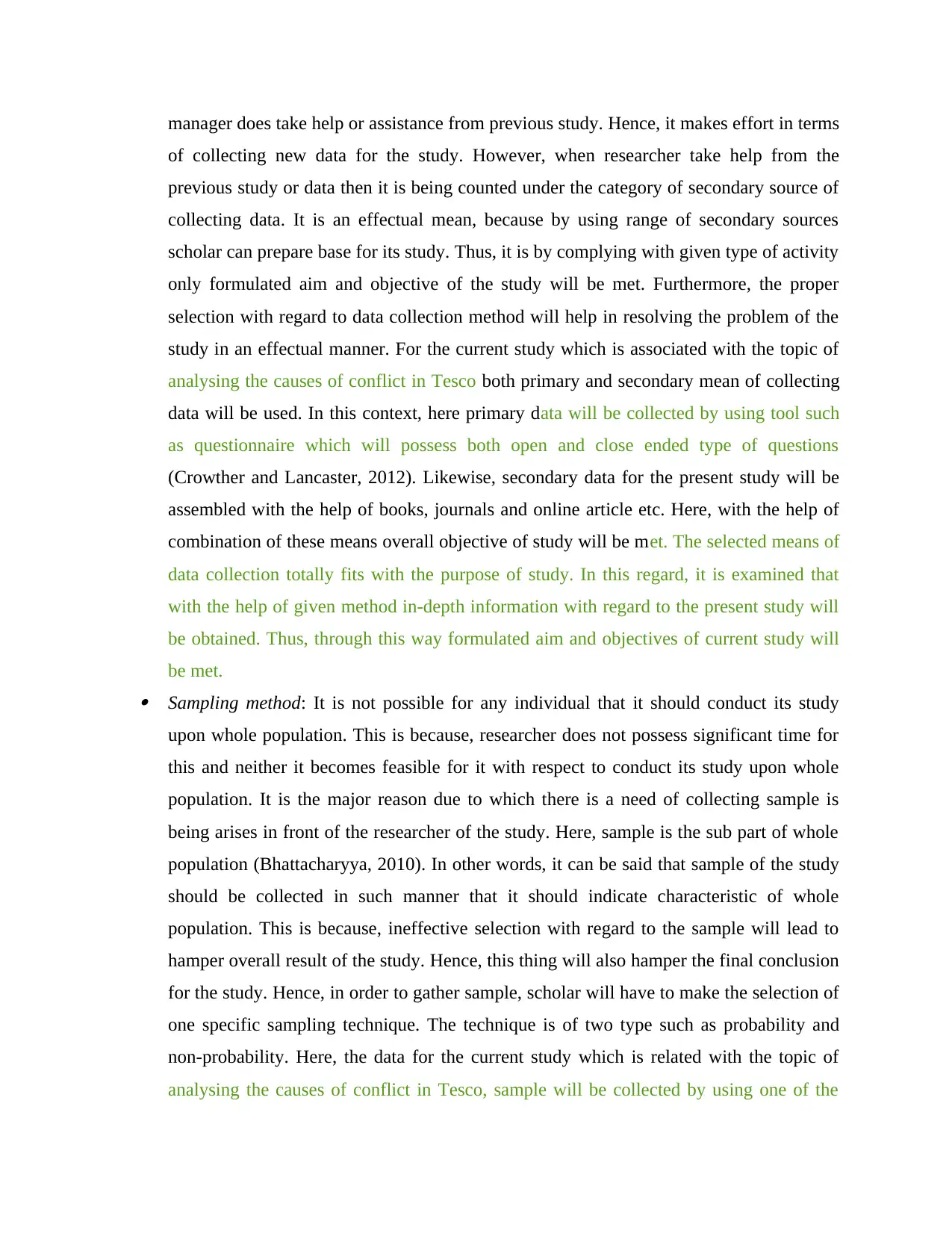
manager does take help or assistance from previous study. Hence, it makes effort in terms
of collecting new data for the study. However, when researcher take help from the
previous study or data then it is being counted under the category of secondary source of
collecting data. It is an effectual mean, because by using range of secondary sources
scholar can prepare base for its study. Thus, it is by complying with given type of activity
only formulated aim and objective of the study will be met. Furthermore, the proper
selection with regard to data collection method will help in resolving the problem of the
study in an effectual manner. For the current study which is associated with the topic of
analysing the causes of conflict in Tesco both primary and secondary mean of collecting
data will be used. In this context, here primary data will be collected by using tool such
as questionnaire which will possess both open and close ended type of questions
(Crowther and Lancaster, 2012). Likewise, secondary data for the present study will be
assembled with the help of books, journals and online article etc. Here, with the help of
combination of these means overall objective of study will be met. The selected means of
data collection totally fits with the purpose of study. In this regard, it is examined that
with the help of given method in-depth information with regard to the present study will
be obtained. Thus, through this way formulated aim and objectives of current study will
be met. Sampling method: It is not possible for any individual that it should conduct its study
upon whole population. This is because, researcher does not possess significant time for
this and neither it becomes feasible for it with respect to conduct its study upon whole
population. It is the major reason due to which there is a need of collecting sample is
being arises in front of the researcher of the study. Here, sample is the sub part of whole
population (Bhattacharyya, 2010). In other words, it can be said that sample of the study
should be collected in such manner that it should indicate characteristic of whole
population. This is because, ineffective selection with regard to the sample will lead to
hamper overall result of the study. Hence, this thing will also hamper the final conclusion
for the study. Hence, in order to gather sample, scholar will have to make the selection of
one specific sampling technique. The technique is of two type such as probability and
non-probability. Here, the data for the current study which is related with the topic of
analysing the causes of conflict in Tesco, sample will be collected by using one of the
of collecting new data for the study. However, when researcher take help from the
previous study or data then it is being counted under the category of secondary source of
collecting data. It is an effectual mean, because by using range of secondary sources
scholar can prepare base for its study. Thus, it is by complying with given type of activity
only formulated aim and objective of the study will be met. Furthermore, the proper
selection with regard to data collection method will help in resolving the problem of the
study in an effectual manner. For the current study which is associated with the topic of
analysing the causes of conflict in Tesco both primary and secondary mean of collecting
data will be used. In this context, here primary data will be collected by using tool such
as questionnaire which will possess both open and close ended type of questions
(Crowther and Lancaster, 2012). Likewise, secondary data for the present study will be
assembled with the help of books, journals and online article etc. Here, with the help of
combination of these means overall objective of study will be met. The selected means of
data collection totally fits with the purpose of study. In this regard, it is examined that
with the help of given method in-depth information with regard to the present study will
be obtained. Thus, through this way formulated aim and objectives of current study will
be met. Sampling method: It is not possible for any individual that it should conduct its study
upon whole population. This is because, researcher does not possess significant time for
this and neither it becomes feasible for it with respect to conduct its study upon whole
population. It is the major reason due to which there is a need of collecting sample is
being arises in front of the researcher of the study. Here, sample is the sub part of whole
population (Bhattacharyya, 2010). In other words, it can be said that sample of the study
should be collected in such manner that it should indicate characteristic of whole
population. This is because, ineffective selection with regard to the sample will lead to
hamper overall result of the study. Hence, this thing will also hamper the final conclusion
for the study. Hence, in order to gather sample, scholar will have to make the selection of
one specific sampling technique. The technique is of two type such as probability and
non-probability. Here, the data for the current study which is related with the topic of
analysing the causes of conflict in Tesco, sample will be collected by using one of the
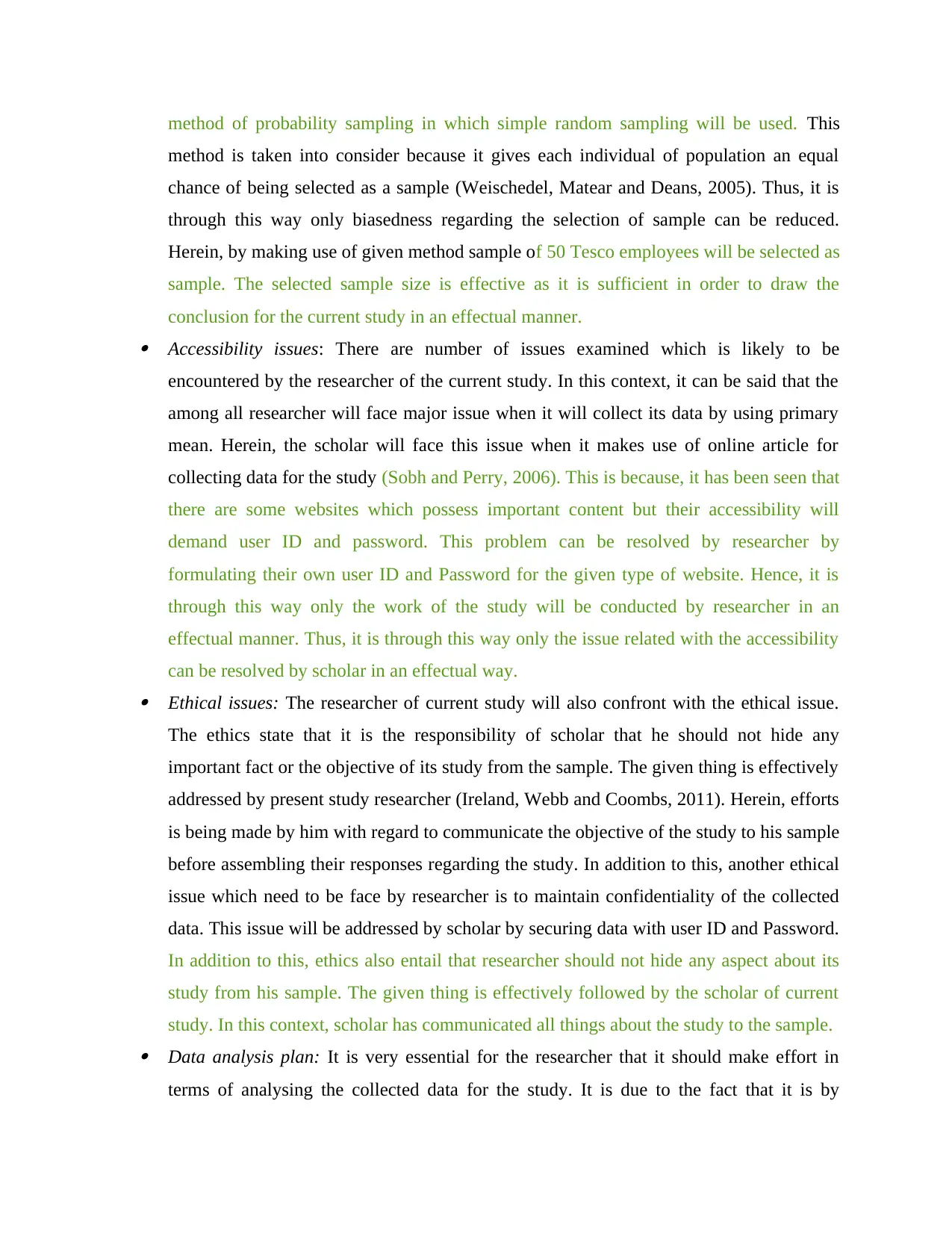
method of probability sampling in which simple random sampling will be used. This
method is taken into consider because it gives each individual of population an equal
chance of being selected as a sample (Weischedel, Matear and Deans, 2005). Thus, it is
through this way only biasedness regarding the selection of sample can be reduced.
Herein, by making use of given method sample of 50 Tesco employees will be selected as
sample. The selected sample size is effective as it is sufficient in order to draw the
conclusion for the current study in an effectual manner. Accessibility issues: There are number of issues examined which is likely to be
encountered by the researcher of the current study. In this context, it can be said that the
among all researcher will face major issue when it will collect its data by using primary
mean. Herein, the scholar will face this issue when it makes use of online article for
collecting data for the study (Sobh and Perry, 2006). This is because, it has been seen that
there are some websites which possess important content but their accessibility will
demand user ID and password. This problem can be resolved by researcher by
formulating their own user ID and Password for the given type of website. Hence, it is
through this way only the work of the study will be conducted by researcher in an
effectual manner. Thus, it is through this way only the issue related with the accessibility
can be resolved by scholar in an effectual way. Ethical issues: The researcher of current study will also confront with the ethical issue.
The ethics state that it is the responsibility of scholar that he should not hide any
important fact or the objective of its study from the sample. The given thing is effectively
addressed by present study researcher (Ireland, Webb and Coombs, 2011). Herein, efforts
is being made by him with regard to communicate the objective of the study to his sample
before assembling their responses regarding the study. In addition to this, another ethical
issue which need to be face by researcher is to maintain confidentiality of the collected
data. This issue will be addressed by scholar by securing data with user ID and Password.
In addition to this, ethics also entail that researcher should not hide any aspect about its
study from his sample. The given thing is effectively followed by the scholar of current
study. In this context, scholar has communicated all things about the study to the sample. Data analysis plan: It is very essential for the researcher that it should make effort in
terms of analysing the collected data for the study. It is due to the fact that it is by
method is taken into consider because it gives each individual of population an equal
chance of being selected as a sample (Weischedel, Matear and Deans, 2005). Thus, it is
through this way only biasedness regarding the selection of sample can be reduced.
Herein, by making use of given method sample of 50 Tesco employees will be selected as
sample. The selected sample size is effective as it is sufficient in order to draw the
conclusion for the current study in an effectual manner. Accessibility issues: There are number of issues examined which is likely to be
encountered by the researcher of the current study. In this context, it can be said that the
among all researcher will face major issue when it will collect its data by using primary
mean. Herein, the scholar will face this issue when it makes use of online article for
collecting data for the study (Sobh and Perry, 2006). This is because, it has been seen that
there are some websites which possess important content but their accessibility will
demand user ID and password. This problem can be resolved by researcher by
formulating their own user ID and Password for the given type of website. Hence, it is
through this way only the work of the study will be conducted by researcher in an
effectual manner. Thus, it is through this way only the issue related with the accessibility
can be resolved by scholar in an effectual way. Ethical issues: The researcher of current study will also confront with the ethical issue.
The ethics state that it is the responsibility of scholar that he should not hide any
important fact or the objective of its study from the sample. The given thing is effectively
addressed by present study researcher (Ireland, Webb and Coombs, 2011). Herein, efforts
is being made by him with regard to communicate the objective of the study to his sample
before assembling their responses regarding the study. In addition to this, another ethical
issue which need to be face by researcher is to maintain confidentiality of the collected
data. This issue will be addressed by scholar by securing data with user ID and Password.
In addition to this, ethics also entail that researcher should not hide any aspect about its
study from his sample. The given thing is effectively followed by the scholar of current
study. In this context, scholar has communicated all things about the study to the sample. Data analysis plan: It is very essential for the researcher that it should make effort in
terms of analysing the collected data for the study. It is due to the fact that it is by
⊘ This is a preview!⊘
Do you want full access?
Subscribe today to unlock all pages.

Trusted by 1+ million students worldwide
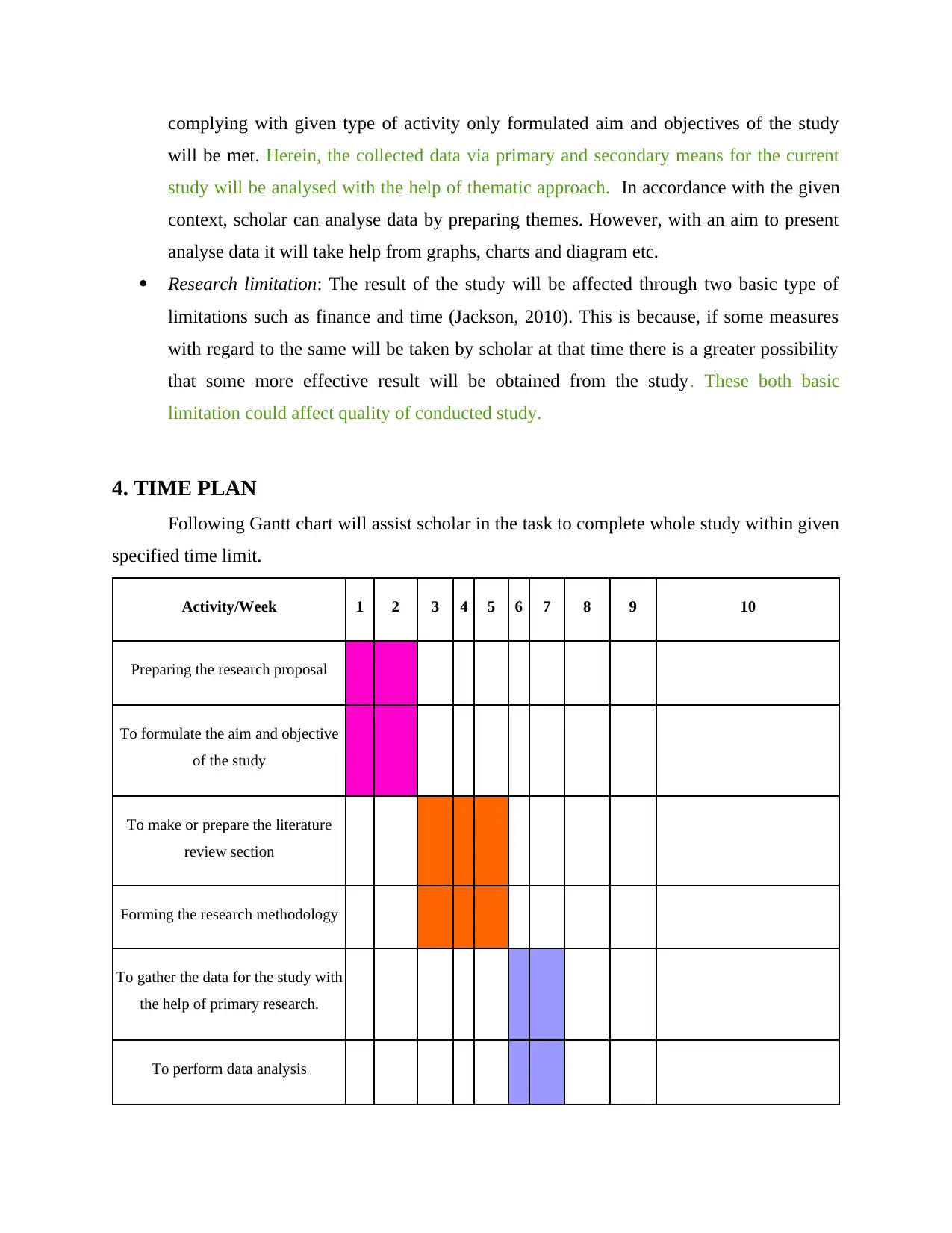
complying with given type of activity only formulated aim and objectives of the study
will be met. Herein, the collected data via primary and secondary means for the current
study will be analysed with the help of thematic approach. In accordance with the given
context, scholar can analyse data by preparing themes. However, with an aim to present
analyse data it will take help from graphs, charts and diagram etc.
Research limitation: The result of the study will be affected through two basic type of
limitations such as finance and time (Jackson, 2010). This is because, if some measures
with regard to the same will be taken by scholar at that time there is a greater possibility
that some more effective result will be obtained from the study. These both basic
limitation could affect quality of conducted study.
4. TIME PLAN
Following Gantt chart will assist scholar in the task to complete whole study within given
specified time limit.
Activity/Week 1 2 3 4 5 6 7 8 9 10
Preparing the research proposal
To formulate the aim and objective
of the study
To make or prepare the literature
review section
Forming the research methodology
To gather the data for the study with
the help of primary research.
To perform data analysis
will be met. Herein, the collected data via primary and secondary means for the current
study will be analysed with the help of thematic approach. In accordance with the given
context, scholar can analyse data by preparing themes. However, with an aim to present
analyse data it will take help from graphs, charts and diagram etc.
Research limitation: The result of the study will be affected through two basic type of
limitations such as finance and time (Jackson, 2010). This is because, if some measures
with regard to the same will be taken by scholar at that time there is a greater possibility
that some more effective result will be obtained from the study. These both basic
limitation could affect quality of conducted study.
4. TIME PLAN
Following Gantt chart will assist scholar in the task to complete whole study within given
specified time limit.
Activity/Week 1 2 3 4 5 6 7 8 9 10
Preparing the research proposal
To formulate the aim and objective
of the study
To make or prepare the literature
review section
Forming the research methodology
To gather the data for the study with
the help of primary research.
To perform data analysis
Paraphrase This Document
Need a fresh take? Get an instant paraphrase of this document with our AI Paraphraser
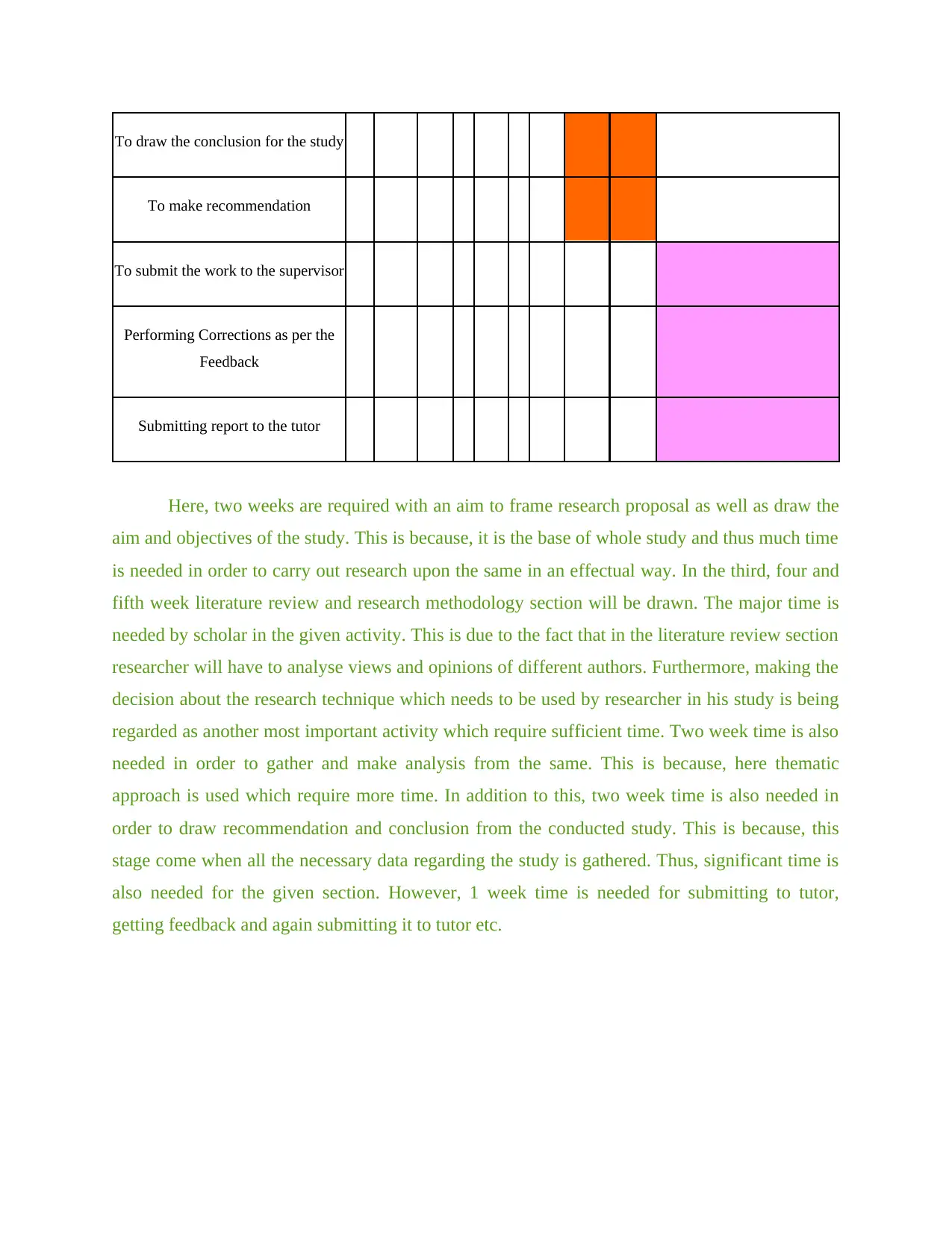
To draw the conclusion for the study
To make recommendation
To submit the work to the supervisor
Performing Corrections as per the
Feedback
Submitting report to the tutor
Here, two weeks are required with an aim to frame research proposal as well as draw the
aim and objectives of the study. This is because, it is the base of whole study and thus much time
is needed in order to carry out research upon the same in an effectual way. In the third, four and
fifth week literature review and research methodology section will be drawn. The major time is
needed by scholar in the given activity. This is due to the fact that in the literature review section
researcher will have to analyse views and opinions of different authors. Furthermore, making the
decision about the research technique which needs to be used by researcher in his study is being
regarded as another most important activity which require sufficient time. Two week time is also
needed in order to gather and make analysis from the same. This is because, here thematic
approach is used which require more time. In addition to this, two week time is also needed in
order to draw recommendation and conclusion from the conducted study. This is because, this
stage come when all the necessary data regarding the study is gathered. Thus, significant time is
also needed for the given section. However, 1 week time is needed for submitting to tutor,
getting feedback and again submitting it to tutor etc.
To make recommendation
To submit the work to the supervisor
Performing Corrections as per the
Feedback
Submitting report to the tutor
Here, two weeks are required with an aim to frame research proposal as well as draw the
aim and objectives of the study. This is because, it is the base of whole study and thus much time
is needed in order to carry out research upon the same in an effectual way. In the third, four and
fifth week literature review and research methodology section will be drawn. The major time is
needed by scholar in the given activity. This is due to the fact that in the literature review section
researcher will have to analyse views and opinions of different authors. Furthermore, making the
decision about the research technique which needs to be used by researcher in his study is being
regarded as another most important activity which require sufficient time. Two week time is also
needed in order to gather and make analysis from the same. This is because, here thematic
approach is used which require more time. In addition to this, two week time is also needed in
order to draw recommendation and conclusion from the conducted study. This is because, this
stage come when all the necessary data regarding the study is gathered. Thus, significant time is
also needed for the given section. However, 1 week time is needed for submitting to tutor,
getting feedback and again submitting it to tutor etc.
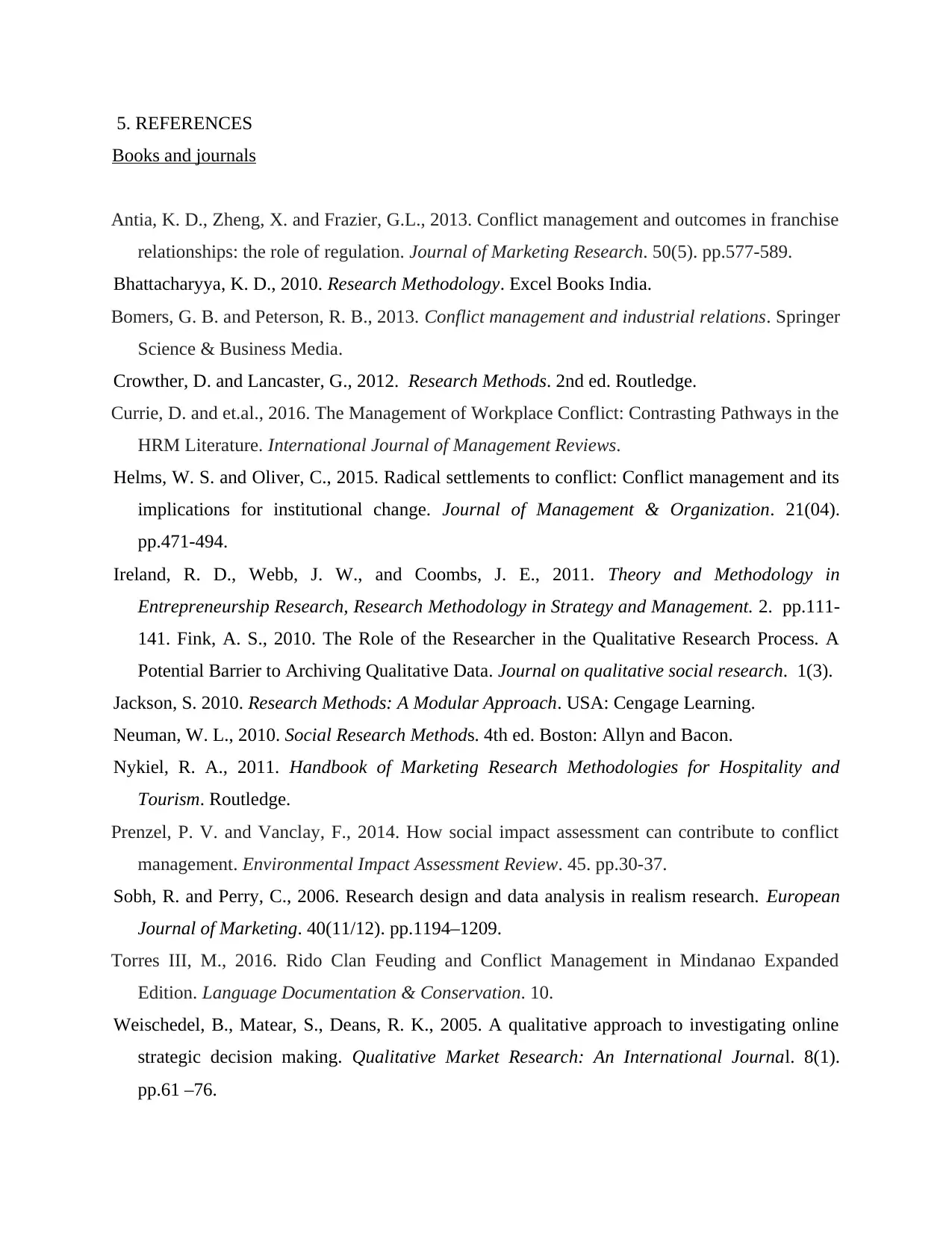
5. REFERENCES
Books and journals
Antia, K. D., Zheng, X. and Frazier, G.L., 2013. Conflict management and outcomes in franchise
relationships: the role of regulation. Journal of Marketing Research. 50(5). pp.577-589.
Bhattacharyya, K. D., 2010. Research Methodology. Excel Books India.
Bomers, G. B. and Peterson, R. B., 2013. Conflict management and industrial relations. Springer
Science & Business Media.
Crowther, D. and Lancaster, G., 2012. Research Methods. 2nd ed. Routledge.
Currie, D. and et.al., 2016. The Management of Workplace Conflict: Contrasting Pathways in the
HRM Literature. International Journal of Management Reviews.
Helms, W. S. and Oliver, C., 2015. Radical settlements to conflict: Conflict management and its
implications for institutional change. Journal of Management & Organization. 21(04).
pp.471-494.
Ireland, R. D., Webb, J. W., and Coombs, J. E., 2011. Theory and Methodology in
Entrepreneurship Research, Research Methodology in Strategy and Management. 2. pp.111-
141. Fink, A. S., 2010. The Role of the Researcher in the Qualitative Research Process. A
Potential Barrier to Archiving Qualitative Data. Journal on qualitative social research. 1(3).
Jackson, S. 2010. Research Methods: A Modular Approach. USA: Cengage Learning.
Neuman, W. L., 2010. Social Research Methods. 4th ed. Boston: Allyn and Bacon.
Nykiel, R. A., 2011. Handbook of Marketing Research Methodologies for Hospitality and
Tourism. Routledge.
Prenzel, P. V. and Vanclay, F., 2014. How social impact assessment can contribute to conflict
management. Environmental Impact Assessment Review. 45. pp.30-37.
Sobh, R. and Perry, C., 2006. Research design and data analysis in realism research. European
Journal of Marketing. 40(11/12). pp.1194–1209.
Torres III, M., 2016. Rido Clan Feuding and Conflict Management in Mindanao Expanded
Edition. Language Documentation & Conservation. 10.
Weischedel, B., Matear, S., Deans, R. K., 2005. A qualitative approach to investigating online
strategic decision making. Qualitative Market Research: An International Journal. 8(1).
pp.61 –76.
Books and journals
Antia, K. D., Zheng, X. and Frazier, G.L., 2013. Conflict management and outcomes in franchise
relationships: the role of regulation. Journal of Marketing Research. 50(5). pp.577-589.
Bhattacharyya, K. D., 2010. Research Methodology. Excel Books India.
Bomers, G. B. and Peterson, R. B., 2013. Conflict management and industrial relations. Springer
Science & Business Media.
Crowther, D. and Lancaster, G., 2012. Research Methods. 2nd ed. Routledge.
Currie, D. and et.al., 2016. The Management of Workplace Conflict: Contrasting Pathways in the
HRM Literature. International Journal of Management Reviews.
Helms, W. S. and Oliver, C., 2015. Radical settlements to conflict: Conflict management and its
implications for institutional change. Journal of Management & Organization. 21(04).
pp.471-494.
Ireland, R. D., Webb, J. W., and Coombs, J. E., 2011. Theory and Methodology in
Entrepreneurship Research, Research Methodology in Strategy and Management. 2. pp.111-
141. Fink, A. S., 2010. The Role of the Researcher in the Qualitative Research Process. A
Potential Barrier to Archiving Qualitative Data. Journal on qualitative social research. 1(3).
Jackson, S. 2010. Research Methods: A Modular Approach. USA: Cengage Learning.
Neuman, W. L., 2010. Social Research Methods. 4th ed. Boston: Allyn and Bacon.
Nykiel, R. A., 2011. Handbook of Marketing Research Methodologies for Hospitality and
Tourism. Routledge.
Prenzel, P. V. and Vanclay, F., 2014. How social impact assessment can contribute to conflict
management. Environmental Impact Assessment Review. 45. pp.30-37.
Sobh, R. and Perry, C., 2006. Research design and data analysis in realism research. European
Journal of Marketing. 40(11/12). pp.1194–1209.
Torres III, M., 2016. Rido Clan Feuding and Conflict Management in Mindanao Expanded
Edition. Language Documentation & Conservation. 10.
Weischedel, B., Matear, S., Deans, R. K., 2005. A qualitative approach to investigating online
strategic decision making. Qualitative Market Research: An International Journal. 8(1).
pp.61 –76.
⊘ This is a preview!⊘
Do you want full access?
Subscribe today to unlock all pages.

Trusted by 1+ million students worldwide
1 out of 13
Related Documents
Your All-in-One AI-Powered Toolkit for Academic Success.
+13062052269
info@desklib.com
Available 24*7 on WhatsApp / Email
![[object Object]](/_next/static/media/star-bottom.7253800d.svg)
Unlock your academic potential
Copyright © 2020–2025 A2Z Services. All Rights Reserved. Developed and managed by ZUCOL.




